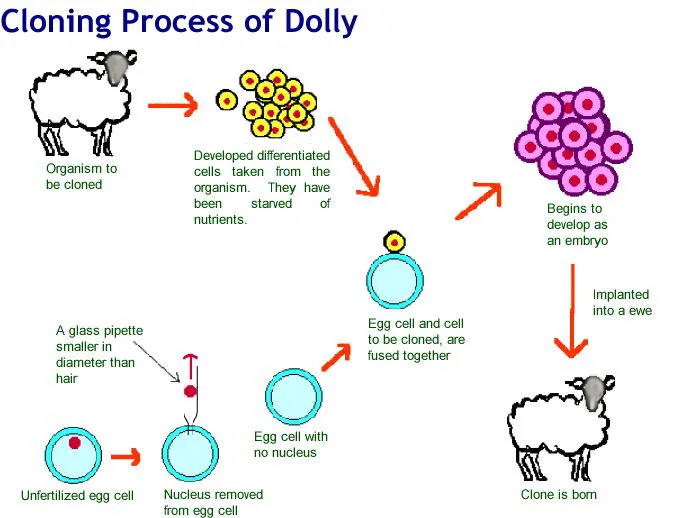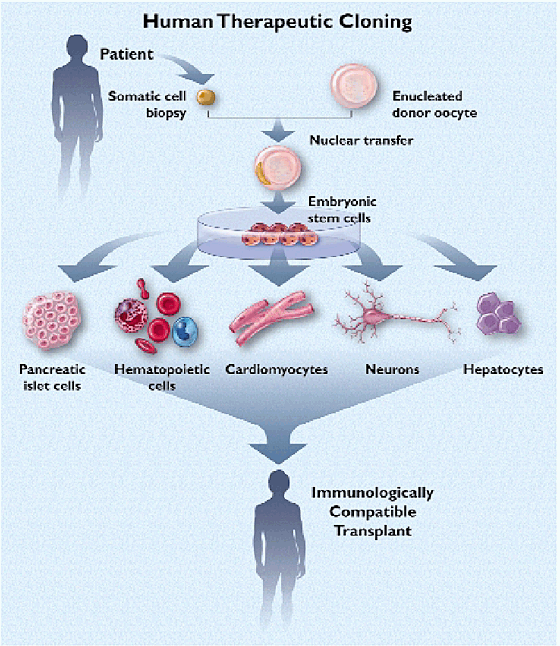Cloning is the process of making an organism, cell, or DNA fragment that is genetically identical to the original. Cloning is of different forms, including DNA cloning, reproductive cloning, and therapeutic cloning.
History of Cloning
Early in the 20th century, when scientists first started experimenting with animal embryonic twinning, cloning first became a reality. By inserting the nucleus of a fertilized frog egg into an enucleated frog egg, Robert Briggs and Thomas King were able to successfully clone tadpoles in 1952. It was the first time a vertebrate animal had been successfully cloned.
In the 1970s, researchers started experimenting with cloning mice by inserting a somatic cell’s nucleus into an enucleated egg. Dolly the sheep was born in 1996, but it wasn’t until the 1990s that cloning technology had improved enough to enable the successful cloning of animals. Dolly was the first mammal to be cloned from an adult somatic cell, and the fact that she was born showed that it was possible to employ cloning technology to create genetically identical replicas of animals for scientific, agricultural, and therapeutic purposes.
Since then, researchers have made more advancements in cloning technology, including increasing the effectiveness of somatic cell nuclear transfer and creating fresh methods for reprogramming adult cells to a pluripotent state, enabling the production of induced pluripotent stem cells (iPSCs) without the use of embryos. These developments have created new opportunities for regenerative medicine and medical research.
Cloning, despite its potential advantages, is still a contentious subject because of ethical issues, particularly when it comes to human reproduction by cloning. Many nations across the world have laws and restrictions governing the use of cloning technology.
Types of Cloning
DNA Cloning
The technique of making multiple copies of a DNA fragment is known as DNA cloning. This is commonly accomplished by a procedure known as polymerase chain reaction (PCR), in which a tiny piece of DNA is amplified using specialized enzymes and nucleotides. Gene sequencing, gene expression analysis, and genetic engineering are just a few of the uses for the copies that are made.
Reproductive Cloning
The technique of developing an organism that is genetically identical to another organism is called reproductive cloning. This is commonly accomplished using a procedure called somatic cell nuclear transfer (SCNT), which involves transferring the nucleus of a somatic cell (i.e., a non-reproductive cell) into an egg cell that has had its own nucleus removed. In a surrogate mother, the resulting embryo is then implanted, where it grows into a clone of the original creature.
Numerous animals, including cats, lambs, and cows, have been cloned through reproductive techniques. The procedure still has a high rate of failure and is only somewhat effective.
Therapeutic Cloning
Therapeutic cloning, also known as somatic cell nuclear transfer (SCNT) cloning, is the process of generating a cloned embryo for the aim of extracting stem cells. Stem cells are undifferentiated cells that have the ability to evolve into a large variety of different cell types, making them valuable for medical study and potentially for disease therapy.
Therapeutic cloning is the same as reproductive cloning, except the resulting embryo is not put into a surrogate mother. Instead, it is taken for its stem cells, which are then cultivated in a laboratory and used for research.
DNA cloning procedure
DNA cloning is the process of creating multiple copies of a DNA fragment using recombinant DNA technology. It is also called as Gene cloning. The basic steps of DNA cloning include:
1. Isolation of the DNA fragment
PCR (polymerase chain reaction) or restriction enzyme digestion are used to isolate the DNA segment to be cloned from its source organism.
2. Preparation of the cloning vector
A cloning vector is a DNA molecule that can transfer a DNA fragment into a host organism. A “multiple cloning site” (MCS) DNA sequence is inserted into a plasmid or viral DNA to create the vector.
3. Digestion of the cloning vector
A restriction enzyme is used to cleave the cloning vector, resulting in a compatible overhang to the ends of the DNA fragment to be cloned. This results in “sticky ends” on both the vector and the DNA fragment, allowing them to anneal to one other.
4. Ligation of the DNA fragment into the vector
The DNA fragment is then ligated (connected together) with the cloning vector by a DNA ligase enzyme, which creates a covalent link between the two pieces of DNA.
5. Transformation of the host organism
The ligated DNA is subsequently transformed and transferred into a host organism, such as bacteria or yeast. The transformed cells are chosen based on their capacity to proliferate in a selective medium containing antibiotics or other chemicals that allow only cells with the cloned DNA to survive.
6. Screening for clones
The transformed cells are then examined to see which ones have the cloned DNA. This is commonly accomplished by the use of a technique known as colony PCR, in which a small piece of the bacterial colony is amplified using PCR and the resulting DNA is tested for the presence of the cloned fragment.
7. Amplification of the cloned DNA
Once a clone containing the desired DNA fragment has been discovered, the DNA can be amplified using PCR or other methods, allowing many copies of the cloned DNA to be produced.

The ability to manipulate and amplify DNA fragments through the process of DNA cloning makes it a potent tool that can be used for a variety of purposes in biotechnology, medicine, and research.
Reproductive cloning Procedure
Reproductive cloning, also known as somatic cell nuclear transfer (SCNT), is the process of creating a genetically identical copy of an organism. The following essential procedures are involved in reproductive cloning:
1. Isolation of donor cells
The animal that will be cloned has a small sample of its cells extracted, often skin cells. Animal DNA is found in these cells.
2. Preparation of egg cell
The nucleus of an egg cell belonging to the same or a closely related species is removed, leaving an empty egg cell in its place.
3. Fusion of donor cells with egg cell
An electrical current is utilized to fuse the two cells after inserting the donor cell’s nucleus into the empty egg cell.
4. Development of embryo
The merged cell is propelled to begin dividing and creating an embryo. The embryo is subsequently placed into the surrogate mother’s womb.
5. Birth of cloned animal
A cloned animal born from the surrogate mother is genetically similar to the donor animal because the surrogate mother carried the cloned embryo to term.

Many different animals, including sheep, cows, cats, and dogs, have been cloned using reproductive cloning. The process still has a high rate of failure and is comparatively inefficient. Reproductive cloning also raises ethical questions about the welfare of the surrogate mother and the possibility of unexpected effects like the emergence of genetic defects or the loss of genetic diversity.
Therapeutic cloning procedure
Somatic cell nuclear transfer (SCNT), another name for therapeutic cloning, is a process that produces cloned embryos for medicinal applications such disease research and drug development. The steps in the process are as follows:
1. Isolation of somatic cells
The patient who will get the therapy has a small sample of somatic cells extracted from them, such as skin cells.
2. Nuclear transfer
A somatic cell’s nucleus is taken out and put into an egg cell whose nucleus has already been taken out.
3. Induction of development
The somatic cell nucleus has now been added to the egg cell, which is then encouraged to divide and form an early-stage embryo.
4. Isolation of embryonic stem cells
The cloned embryo is used to isolate embryonic stem cells. Any sort of cell in the body could differentiate from these cells.
5. Differentiation of stem cells
The separated embryonic stem cells can be stimulated to develop into particular cell types, including heart or nerve cells.
6. Transplantation of differentiated cells
To replace harmed or sick cells, the differentiated cells can be transplanted into the patient’s body.

Therapeutic cloning has the potential to offer individualized treatments for a range of disorders since the cloned embryonic stem cells are genetically identical to the patient and less likely to be rejected by the patient’s immune system. Due to ethical issues with the death of embryos, the use of embryonic stem cells is debatable. Other stem cell forms, like induced pluripotent stem cells (iPSCs), which may be produced from adult cells without using embryos, are also being investigated by researchers.
Application of Cloning
Cloning has a wide range of potential applications in various fields, including:
- Medical research: Cloning can create animal models of human diseases that can be utilized to research the illness and provide brand-new remedies.
- Biotechnology: For industrial or medical uses, cloning can be employed to manufacture vast numbers of proteins and other substances.
- Agriculture: Cloning is a technique that can be used to replicate superior livestock or crops, boosting food production and enhancing food security.
- Conservation: Cloning can be used to save extinct species or revive endangered ones.
- Reproductive technology: Cloning can assist same-sex couples or infertile couples in conceiving biological children.
- Therapeutic cloning: Embryonic stem cells can be produced through cloning and employed in regenerative medicine.
Cloning, however, also prompts ethical questions, particularly when it comes to reproductive cloning and the potential for generating genetically altered people. The focus has turned away from utilizing cloning techniques for reproduction and toward using them for medical and scientific study as a result, making the use of cloning in humans highly regulated and contentious.
Ethical Considerations
Numerous ethical questions have been raised by the use of cloning, particularly in relation to reproductive cloning. Some contend that cloning is unethical since it meddles with human life and interferes with the body’s normal reproductive process. Others contend that, particularly in the case of therapeutic cloning, the potential advantages of cloning exceed the ethical issues.